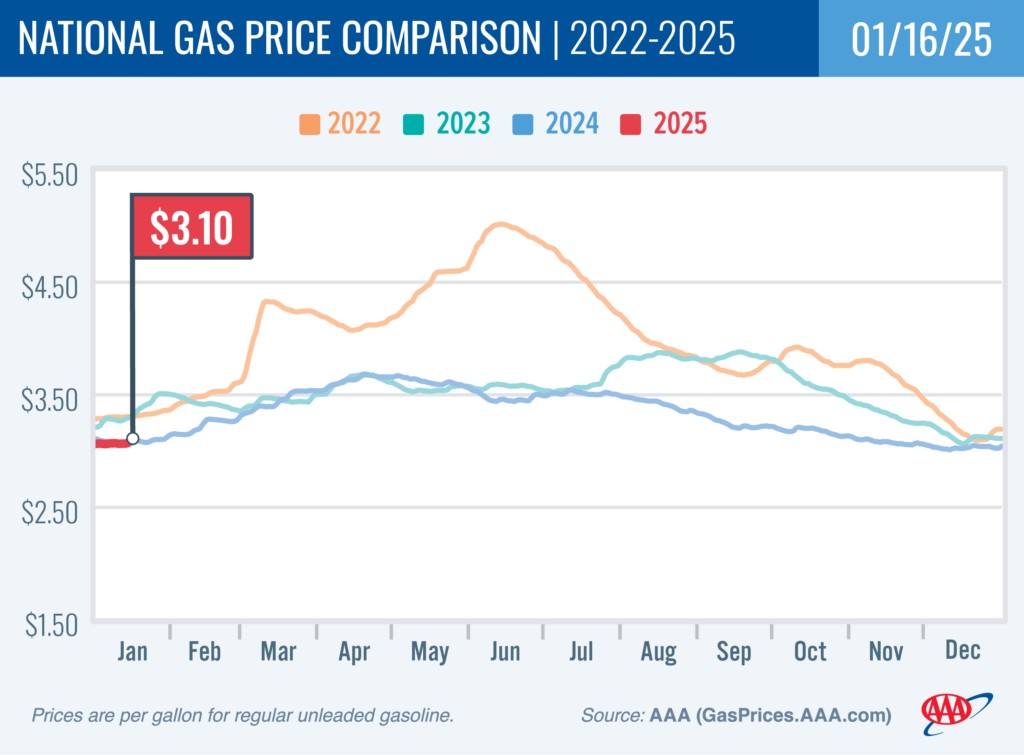Gasoline prices across the nation have seen a recent uptick, prompting many drivers to wonder, Why Did Gas Prices Go Up? As of this week, the national average for a gallon of gas has risen by four cents, reaching $3.10. This increase comes despite consistent electric vehicle (EV) charging costs at public stations, which remain stable at 34 cents per kilowatt-hour. To understand this fuel price fluctuation, it’s essential to delve into the dynamics of the oil market and other contributing factors.
Andrew Gross, spokesperson for AAA, explains, “Domestic gasoline demand is currently low, so the question isn’t about local consumption driving prices. The real driver is the increasing cost of oil.” He further clarifies, “Global oil prices have experienced a surge due to a combination of strong demand for winter heating fuel and the impact of new U.S. sanctions targeting Russia’s energy sector. Given that crude oil costs constitute 56% of the price we pay at the pump, any rise in oil prices directly translates to higher gasoline prices.” Despite this overall increase, Gross points out that 26 states still maintain average gas prices below $3 a gallon, indicating regional variations.
 Map of US gas prices on January 16, 2025, illustrating the varying costs of gasoline across different states due to factors like oil prices and regional demand.
Map of US gas prices on January 16, 2025, illustrating the varying costs of gasoline across different states due to factors like oil prices and regional demand.
Recent data from the Energy Information Administration (EIA) supports the analysis of demand and supply factors. Gasoline demand has actually decreased, falling from 8.48 million barrels per day last week to 8.32 million. Simultaneously, total domestic gasoline inventories have increased from 237.7 million barrels to 243.6 million barrels. Moreover, gasoline production saw a boost last week, averaging 9.3 million barrels daily. This data suggests that the increase in gas prices is not driven by increased demand or decreased supply of gasoline itself, reinforcing the focus on oil prices as the primary cause.
Comparing current prices to previous periods, today’s national average of $3.10 per gallon is eight cents higher than a month ago and three cents higher than at the same time last year. This gradual increase underscores the ongoing influence of oil market trends on gasoline costs.
Oil Market Factors Influencing Gas Prices
The dynamics of the crude oil market further illuminate why did gas prices go up. At the close of Wednesday’s trading, West Texas Intermediate (WTI) crude oil prices rose significantly by $2.54, settling at $80.04 per barrel. The EIA also reported a decrease in U.S. crude oil inventories by 2.0 million barrels from the previous week. Currently, at 412.7 million barrels, U.S. crude oil inventories are approximately 6% below the five-year average for this period. This reduction in crude oil inventories, coupled with increased global demand and geopolitical factors such as sanctions, contributes to the upward pressure on oil prices, and subsequently, on gas prices.
Regional Gas Price and Electric Charging Variations
It’s important to note the significant regional differences in both gasoline and electric charging costs across the United States.
States with the Most Expensive Gasoline:
- Hawaii ($4.54)
- California ($4.41)
- Washington ($3.90)
- Nevada ($3.66)
- Oregon ($3.50)
- Pennsylvania ($3.32)
- Alaska ($3.31)
- Illinois ($3.25)
- Washington, DC ($3.23)
- Florida ($3.22)
States with the Least Expensive Gasoline:
- Mississippi ($2.66)
- Texas ($2.68)
- Oklahoma ($2.70)
- Arkansas ($2.71)
- Louisiana ($2.76)
- Kentucky ($2.76)
- Kansas ($2.77)
- Alabama ($2.79)
- Missouri ($2.79)
- Kentucky ($2.77)
States with the Least Expensive Public EV Charging (per kWh):
- Kansas (22 cents)
- Nebraska (25 cents)
- Missouri (25 cents)
- Delaware (27 cents)
- Texas (28 cents)
- Maryland (28 cents)
- Utah (29 cents)
- North Dakota (29 cents)
- Michigan (30 cents)
- Iowa (30 cents)
States with the Most Expensive Public EV Charging (per kWh):
- Hawaii (51 cents)
- Montana (45 cents)
- West Virginia (45 cents)
- Idaho (42 cents)
- New Hampshire (42 cents)
- Kentucky (42 cents)
- Arkansas (42 cents)
- Tennessee (42 cents)
- Louisiana (41 cents)
- South Carolina (41 cents)
For drivers seeking the most current gas and electric charging prices along their routes, resources like the AAA TripTik Travel planner are available to provide up-to-date information and assist in planning cost-effective journeys. In conclusion, the recent rise in gas prices can be primarily attributed to increasing global oil prices, influenced by winter heating fuel demand and geopolitical factors, despite stable domestic gasoline demand and supply levels.
